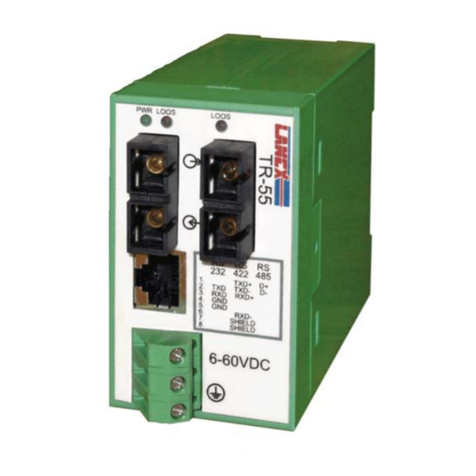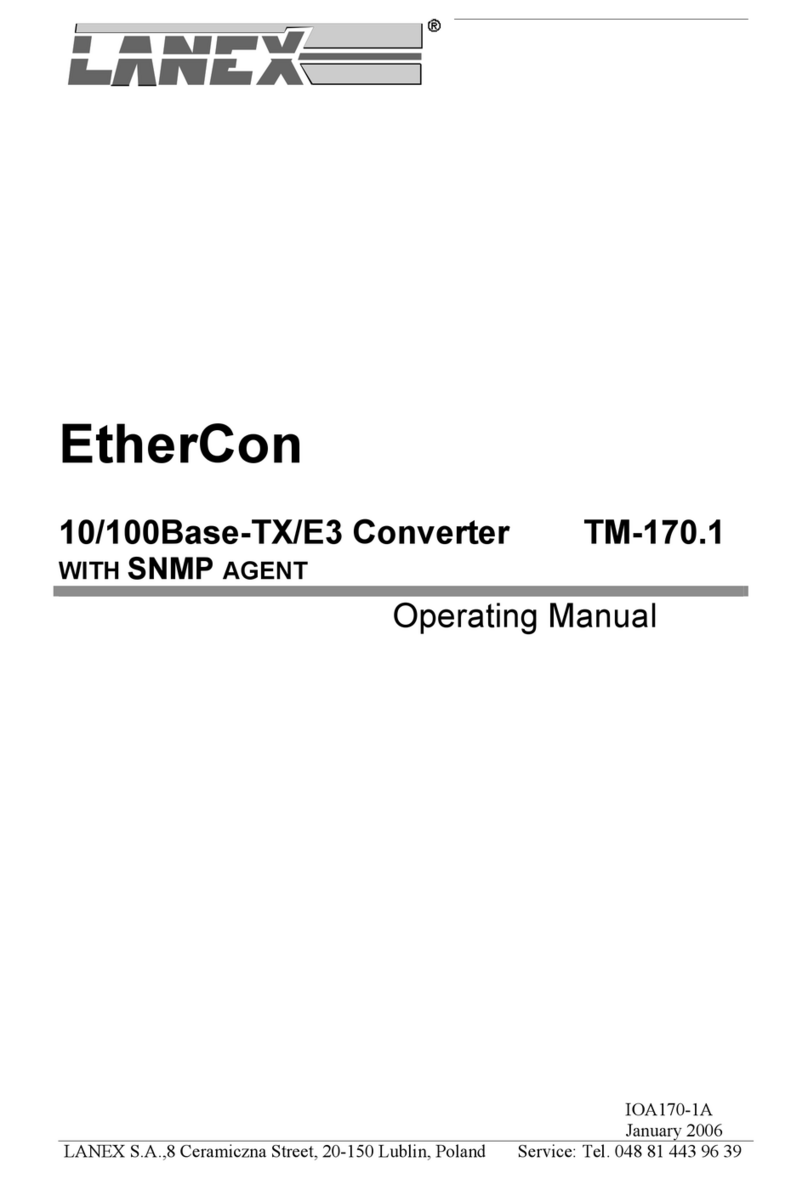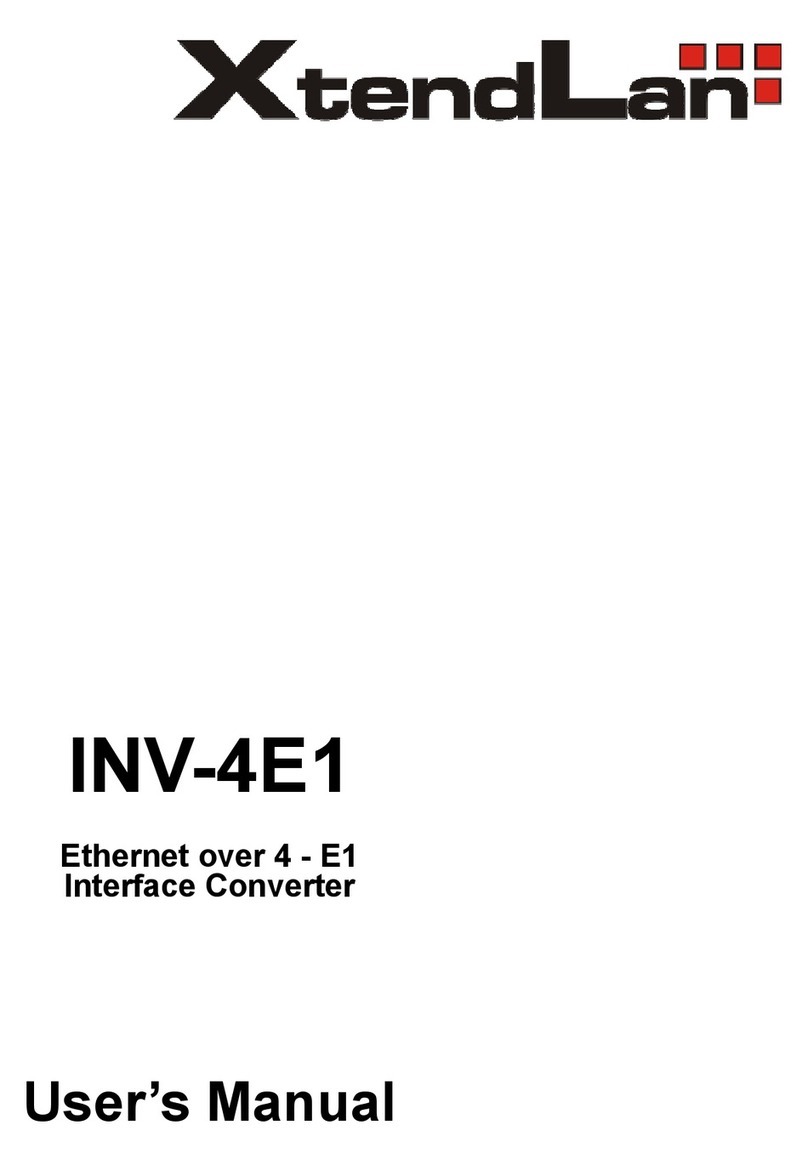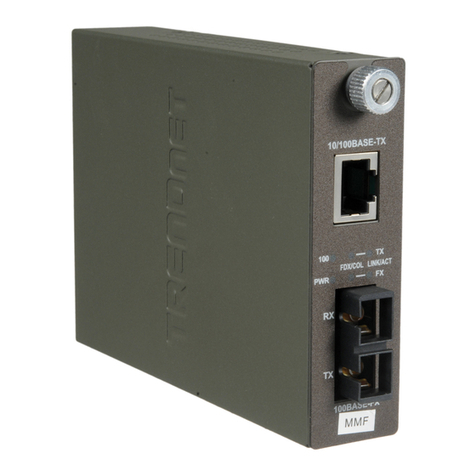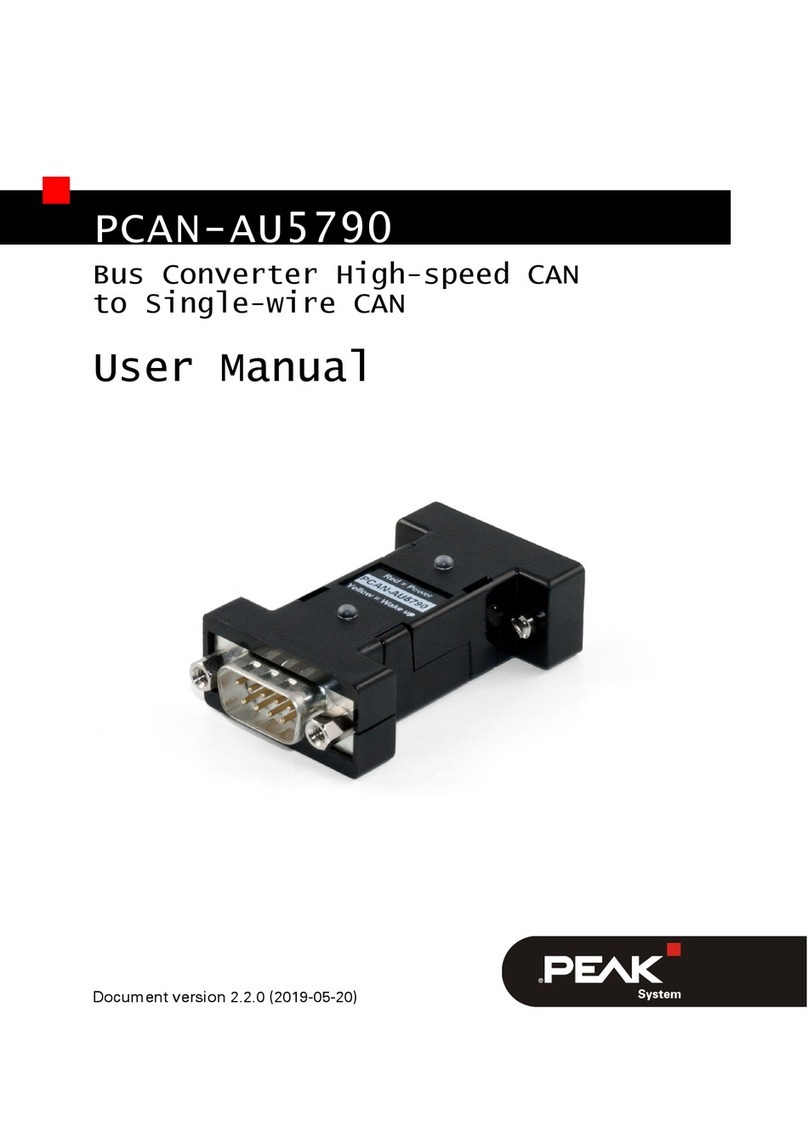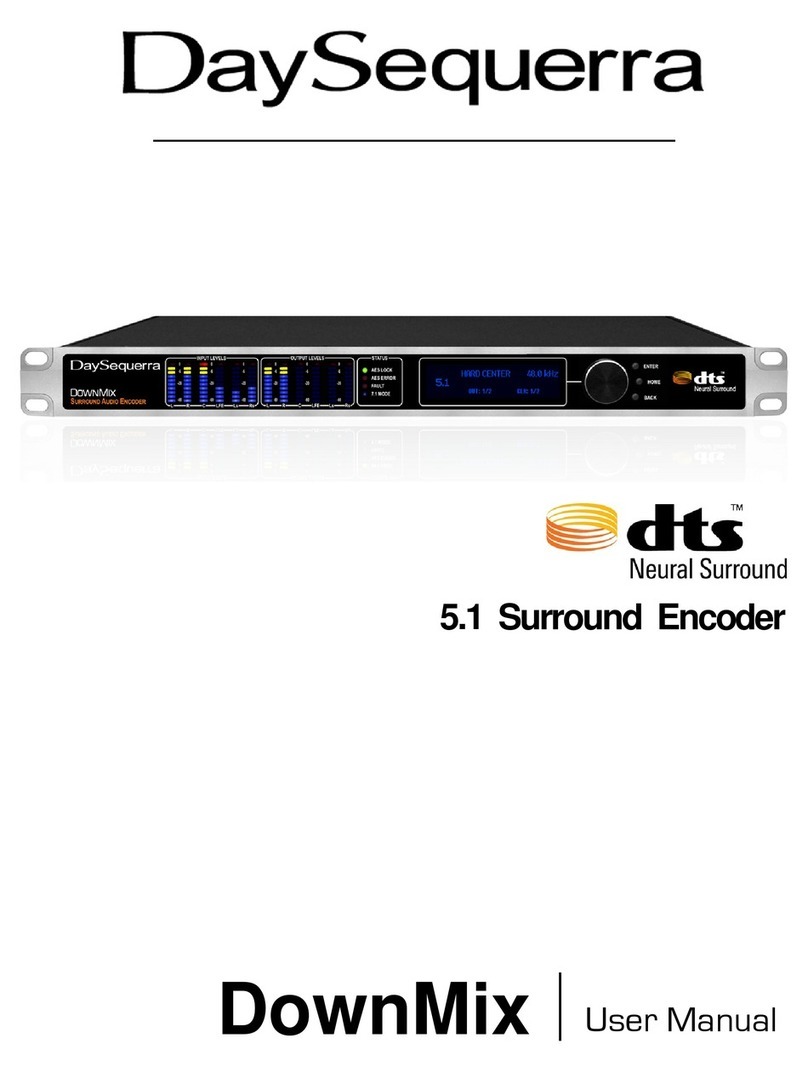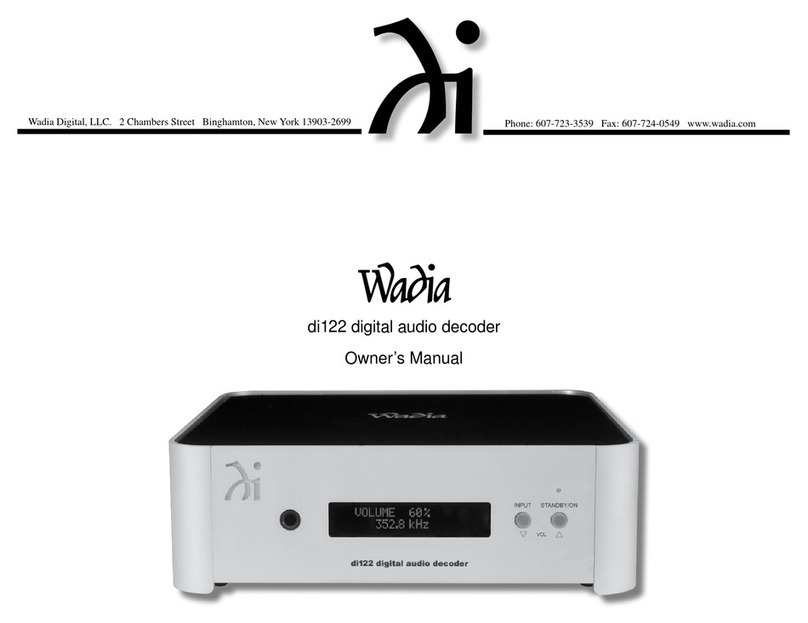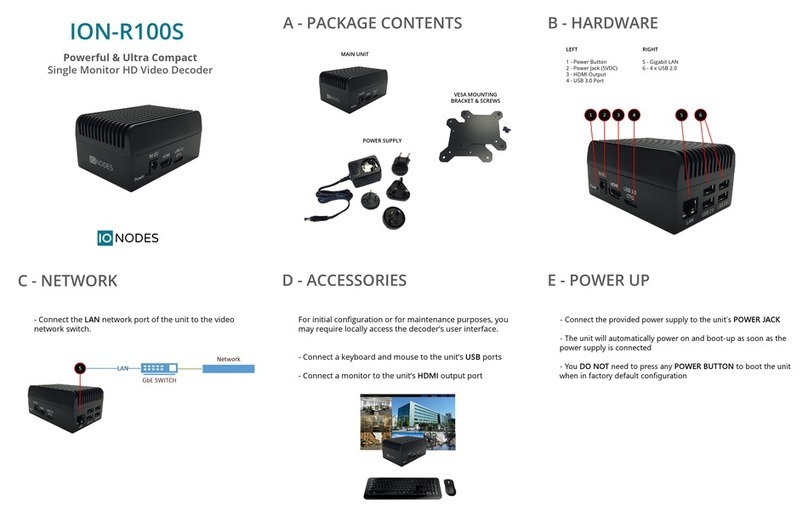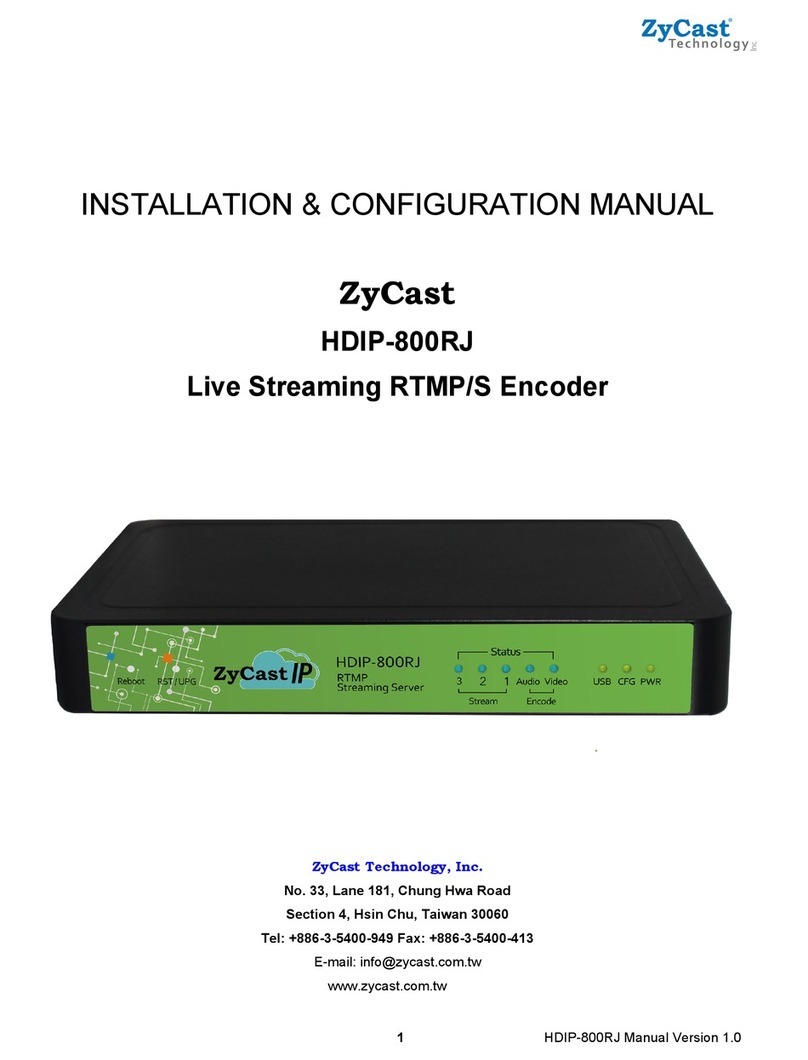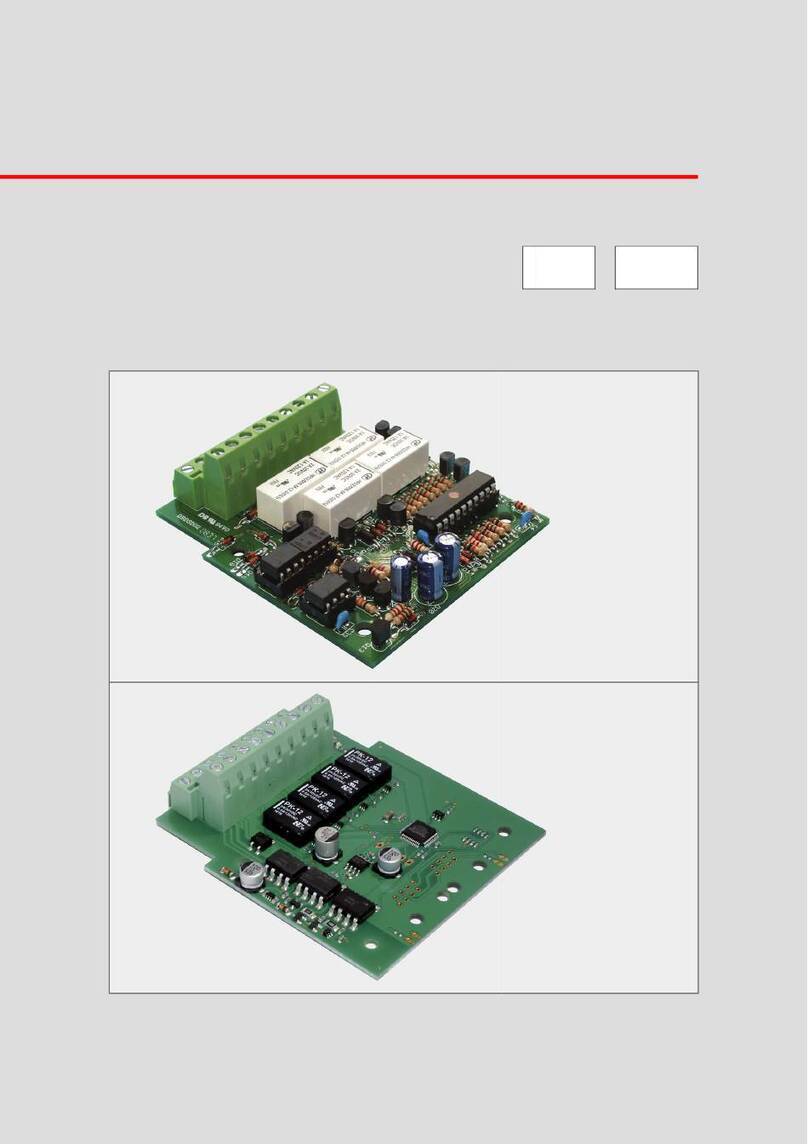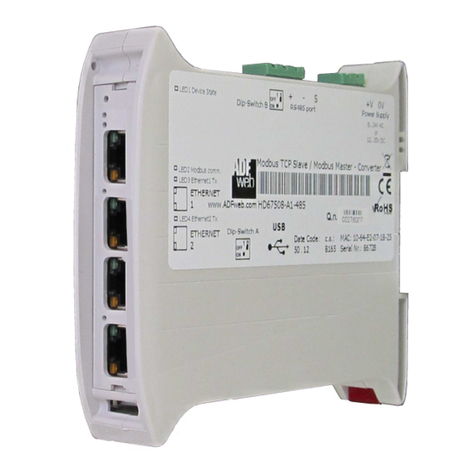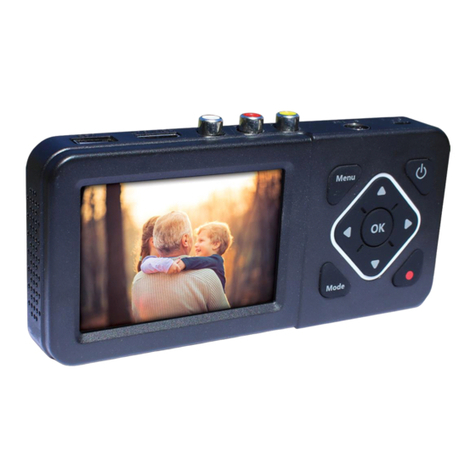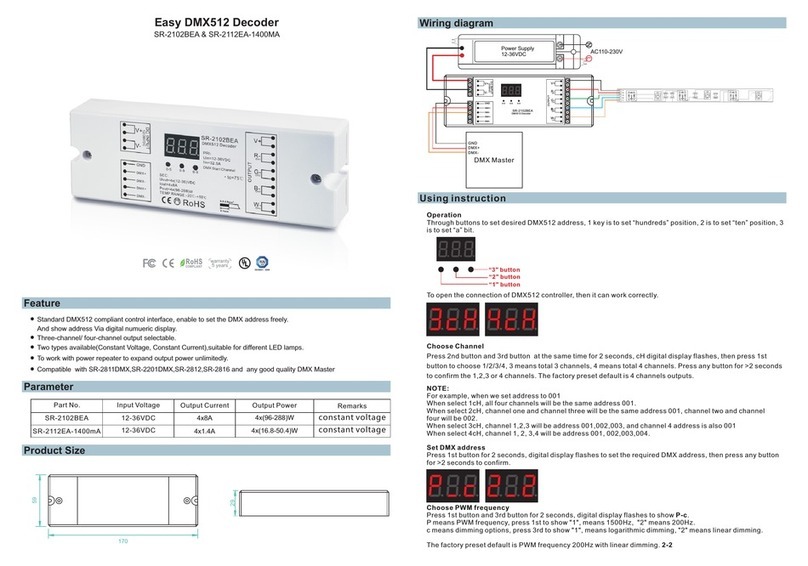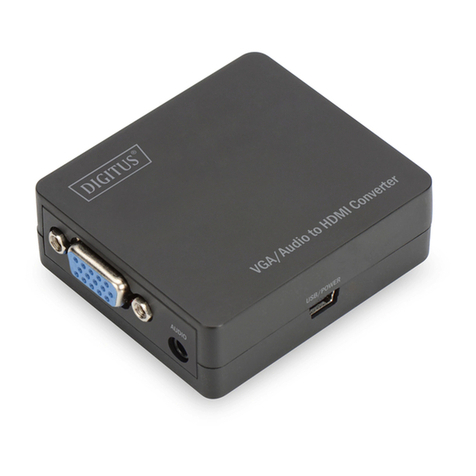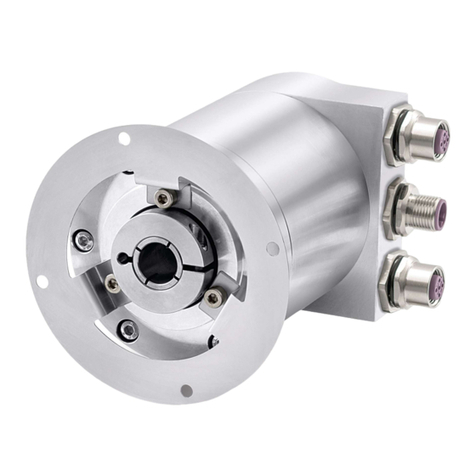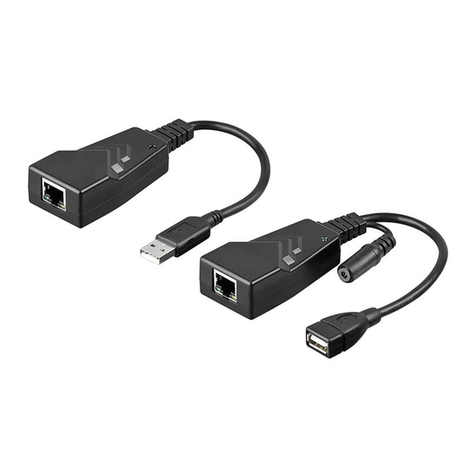Lanex TM-78 User manual

IOA78-1C
January 2005
LANEX S.A., 8 Ceramiczna Street, 20-150 Lublin POLAND service phone no.
+48 81 443 96 39
EtherTel
10/100Base-T/ E1 Converter TM-78
Operating Manual

10Base-T/100Base-TX/E1 Converter
Operating Manual
IOA78-1C I January 2005
Table of Contents
1. GENERAL DESCRIPTION ......................................................................................... 1
1.1. Designed use .............................................................................................................................. 1
1.2. Sample applications .................................................................................................................. 2
1.3. Integration with other manufacturers’ equipment................................................................ 3
1.4. Labeling ..................................................................................................................................... 3
2. CONNECTORS AND LED INDICATORS ..................................................................... 4
2.1. Front panel ................................................................................................................................ 4
2.2. Rear panel.................................................................................................................................. 5
2.3. Description of connectors ......................................................................................................... 6
3. FUNCTIONAL DESCRIPTION..................................................................................... 7
3.1. Rule of operation....................................................................................................................... 7
3.2. Clock .......................................................................................................................................... 7
3.3. Diagnostic and signaling systems............................................................................................. 7
3.4. Test loops ................................................................................................................................... 8
3.5. Quality management............................................................................................................... 10
3.6. Event log .................................................................................................................................. 11
3.7. Service channels ...................................................................................................................... 11
4. INSTALLATION & OPERATION ............................................................................... 12
4.1. Introduction............................................................................................................................. 12
4.2. Working conditions................................................................................................................. 12
4.3. Power Supply .......................................................................................................................... 12
4.4. Connecting connection cables ................................................................................................ 13
4.4.1. Ethernet interface ................................................................................................................. 13
4.4.2. E1/G.703 line interface ........................................................................................................ 13
4.5. Attachment of surveillance cables ......................................................................................... 14
4.6. Clock setup .............................................................................................................................. 15
4.7. Configuration of the E1 G.703 interface............................................................................... 15
5. CONVERTER SETUP WITH LANWIN SOFTWARE ...................................................... 16
5.1. Global setup............................................................................................................................. 16
5.1.1. Device Name........................................................................................................................ 17
5.1.2. Date and time setting............................................................................................................ 17
5.1.3. Additional information......................................................................................................... 17
5.2. Interfaces ................................................................................................................................. 18
5.2.1. E1, Setup tab ........................................................................................................................ 18
5.3. Global clock............................................................................................................................. 23
5.4. Log............................................................................................................................................ 24
5.4.1. Event log tab ........................................................................................................................ 24
5.4.2. Event log tab, event log filters ............................................................................................. 25
5.5. G.826 statistics......................................................................................................................... 28
5.5.1. G.826 statistics, Counters tab............................................................................................... 28
6. TECHNICAL SPECIFICATION .................................................................................. 32
6.1. Electrical characteristics ........................................................................................................ 32
6.1.1. Ethernet interface ................................................................................................................. 32
6.1.2. E1/G.703 line interface ........................................................................................................ 32
6.2. Mechanical parameters .......................................................................................................... 32
6.3. Environmental requirements................................................................................................. 33
6.3.1. Operation.............................................................................................................................. 33
6.3.2. Transport.............................................................................................................................. 33
6.3.3. Storage ................................................................................................................................. 33
6.4. Electromagnetic compatibility............................................................................................... 33
6.5. Power Supply .......................................................................................................................... 33
7. PRODUCT ELEMENTS AND ACCESSORIES .............................................................. 34

10Base-T/100Base-TX/E1 Converter
Operating Manual
IOA78-1C II January 2005
Drawings
Figure 1-2: Example application II. ............................................................................... 2
Figure 1-3: Example application III............................................................................... 3
Figure 2-1: Layout and description of the front panel. .................................................. 4
Figure 2-2: Layout and description of the rear panel..................................................... 5
Figure 2-3: RJ-45 surveillance connector ...................................................................... 6
Figure 2-4: E1/G.703. interface connector..................................................................... 6
Figure 2-5: Ethernet MDI interface connector - port 1 and 2. ....................................... 6
Figure 2-6: MDIX Ethernet interface connector - port 2. .............................................. 6
Figure 3-1: Rules of introducing and using the LOOP1 local loop. .............................. 9
Figure 3-2: Rules of introducing and using the LOOP2 remote loop. ........................... 9
Figure 3-3: Device unavailability................................................................................. 11
Figure 4-1: Ethernet interface RJ-45 male connector. ................................................. 13
Figure 4-2: Method of connecting crossed cable. ........................................................ 13
Figure 4-3. E1/G.703. interface RJ-45 male connector. .............................................. 13
Figure 4-4: RS-232 cable with DB-9 RJ-45 pins.................................................... 14
Figure 5-1: Global setup............................................................................................... 16
Figure 5-2: Device Name. ............................................................................................ 17
Figure 5-3: Date and time setting................................................................................. 17
Figure 5-4: Additional information.............................................................................. 17
Figure 5-5: Interfaces - E1, Setup. ............................................................................... 18
Figure 5-6: Interfaces - E1, Loops. .............................................................................. 19
Figure 5-7: Interfaces - E1, Monitoring. ...................................................................... 20
Figure 5-8: Interfaces - Ethernet, Setup. ...................................................................... 21
Figure 5-9: Interfaces - Ethernet, Monitoring. ............................................................. 22
Figure 5-10: Global clock. ........................................................................................... 23
Figure 5-11: Log - Event log........................................................................................ 24
Figure 5-12: Log - Event log filters. ............................................................................ 25
Figure 5-13. Event log filter – Date. ............................................................................ 26
Figure 5-14. Event log filter – UAL/NUAL. ............................................................... 27
Figure 5-15. G.826 statistics – 15-minute counters. .................................................... 29
Figure 5-16. G.826 statistics – 24-hour counters. ........................................................ 29
Figure 5-17. G.826 statistics – Time periods. .............................................................. 30
Figure 5-18. Count initialization time.......................................................................... 30
Figure 5-19. Ranges. .................................................................................................... 30
Figure 5-20. Alarm on thresholds. ............................................................................... 31
Figure 5-21. Alarms hierarchy. .................................................................................... 31

10Base-T/100Base-TX/E1 Converter
Operating Manual
IOA78-1C III January 2005
Abbreviations
AIS Alarm Indication Signal
NUAL Non-urgent Alarm
UAL Urgent Alarm
ES Errored Seconds
ES15 15-minute Errored Seconds Counter ES
ES24 24-hour Errored Seconds Counter ES
HDLC High Level Data Link Control
IEEE Institute of Electrical and Electronics Engineers
ITU-T International Telecommunication Union – Telecommunication
Standardization Sector
LOF Loss Of Frame
LOS Loss Of Signal
MDI Medium Dependent Interface
MII Medium Independent Interface
SES Severely Errored Second
SES15 15-minute Severely Errored Seconds Counter SES
SES24 24-hour Severely Errored Seconds Counter SES
LOF Loss of Frame

10Base-T/100Base-TX/E1 Converter
Operating Manual
IOA78-1C IV January 2005
Operating Safety
The EtherTel TM-78 converter has been designed and tested in the range of safety and
operation in accordance with the PN-EN-60950 standards. It conforms to Class I safety
requirements.
!The earthing clamp located on the rear wall of the device should be connected
to earth.
!The device is not provided with an integrated tripping system. Such system
should be located outside the device.
The manufacturer shall not be held liable for use of the device contrary to this
operating manual.
The operating manual is a part of supply and is delivered to users together with
the device.

10Base-T/100Base-TX/E1 converter
Operating Manual
_______________________________________________________________________________
IOA78-1C 1 January 2005
1. GENERAL DESCRIPTION
1.1. Designed use
EtherTel TM-78 is a converter that enables connecting independent segments of local
area networks in Ethernet 10BASE-T and 100BASE-TX standard, using SDH or PDH
telecommunication network, on the basis of framed signal with transmission rate of 2048 kbit/s,
structure specified in guideline G.704, interface according to guideline G.703. Data transmission
rate can be one of n x 64 kbit/s, where n = 1 ÷ 31. Operation in non-framed mode is also possible
at full speed of 2048 kbit/s.
Each Ethernet package has a destination address field, determining the destination for
transmitted data. EtherTel receives the incoming package and verifies its destination address,
then compares the address with source addresses collected from previous frames and decides
whether the frame should be sent to a second port or not. Therefore, network segments can be
isolated and network capacity can be increased. Flow control, compliant with IEEE802.3x,
determines the method of sending the frames in full duplex mode so that to avoid overloading the
converter.
EtherTel converter also transparently transfers Ethernet frames longer than 1522
bytes, belonging to virtual networks according to IEEE 802.1Q standard, or to setting priorities
IEEE 802.1p.

10Base-T/100Base-TX/E1 converter
Operating Manual
_______________________________________________________________________________
IOA78-1C 2 January 2005
1.2. Sample applications
One of the simplest applications is the possibility of providing Internet access service using
telecommunication network with transmission speed gradation n x 64 kbit/s. The service operator
may freely switch the range, depending on the user’s requirements and capacity (Figure 1-1).
Telecommunication
network
E1/G.703
E1/G.703
Switch
Ethernet
Switch
Ethernrt
Internet
10/100BASE-T/E1 CONVERTER
EtherTel
RS-232
DCE 5-RxD
4-SG
6-TxD
LOOP1
10/100BAS E-T
E1
LOOP2
LOS
LOF
TXD
LN
K
A
C
T
LN
K
ACT
A
IS
ERR
RXD
10/100
10/100
FD/COL
FD/COL
2
1
MENAGEMENT
10/100BASE-T/E1 CONVERTER
EtherTel
RS-232
DCE 5-RxD
4-SG
6-TxD
LOOP1
10/100BASE- T
E1
LOOP2
LOS
LOF
TXD
LNK
A
CT
LNK
AC
T
A
IS
ERR
RXD
10/100
10/100
FD/COL
FD/COL
2
1
MENAGEMENT
EtherTel
EtherTel
Figure 1-1: Example application I.
Figure 1-2 presents network configuration enabling cooperation of four workgroups in
remote locations. Fibre optic and copper lines are used, with the SHDSL technology.
4xE1/G.703
Location 1
TM-75
Switch
Ethernet
TM-44
TM-44
Fiber optic line
E1
SHDSL
Location 2
Location 3
Location 4
TM-75
TM-75
TM-75
TM-75
TM-75
TM-75
TM-75
SHDSL
SHDSL
SHDSL
4xE1/G.703
E1
E1
E1
10/100BASE-T/E1 CONVERTER
Et
h
erTe
l
RS-232
DCE 5-RxD
4-SG
6-TxD
LOOP1
10/100BASE-T
E1
LOOP2
LOS
LOF
TXD
LNK
A
C
T
LNK
ACT
AIS
ERR
RXD
10/100
10/100
FD/COL
FD/COL
2
1
MENAGEMENT
10/100BASE-T/E1 CONVERTER
Et
h
erTe
l
RS-232
DCE 5-RxD
4-SG
6-TxD
LOOP1
10/100BASE-T
E1
LOOP2
LOS
LOF
TXD
LNK
A
C
T
LNK
ACT
AIS
ERR
RXD
10/100
10/100
FD/COL
FD/COL
2
1
MENAGEMENT
10/100BASE-T/E1 CONVERTER
Et
h
erTe
l
RS-232
DCE 5-RxD
4-SG
6-TxD
LOOP1
10/100BASE-T
E1
LOOP2
LOS
LOF
TXD
LNK
A
C
T
LNK
ACT
AIS
ERR
RXD
10/100
10/100
FD/COL
FD/COL
2
1
MENAGEMENT
10/100BASE-T/E1 CONVERTER
Et
h
erTe
l
RS-232
DCE 5-RxD
4-SG
6-TxD
LOOP1
10/100BASE-T
E1
LOOP2
LOS
LOF
TXD
LNK
A
C
T
LNK
ACT
AIS
ERR
RXD
10/100
10/100
FD/COL
FD/COL
2
1
MENAGEMENT
10/100BASE-T/E1 CONVERTER
Et
h
erTe
l
RS-232
DCE 5-RxD
4-SG
6-TxD
LOOP1
10/100BASE-T
E1
LOOP2
LOS
LOF
TXD
LNK
A
CT
LNK
ACT
AIS
ERR
RXD
10/100
10/100
FD/COL
FD/COL
2
1
MENAGEMENT
10/100BASE-T/E1 CONVERTER
Et
h
erTe
l
RS-232
DCE 5-RxD
4-SG
6-TxD
LOOP1
10/100BASE-T
E1
LOOP2
LOS
LOF
TXD
LNK
A
CT
LNK
ACT
AIS
ERR
RXD
10/100
10/100
FD/COL
FD/COL
2
1
MENAGEMENT
10/100BASE-T/E1 CONVERTER
Et
h
erTe
l
RS-232
DCE 5-RxD
4-SG
6-TxD
LOOP1
10/100BASE-T
E1
LOOP2
LOS
LOF
TXD
LNK
A
CT
LNK
ACT
AIS
ERR
RXD
10/100
10/100
FD/COL
FD/COL
2
1
MENAGEMENT
10/100BASE-T/E1 CONVERTER
Et
h
erTe
l
RS-232
DCE 5-RxD
4-SG
6-TxD
LOOP1
10/100BASE-T
E1
LOOP2
LOS
LOF
TXD
LNK
A
CT
LNK
ACT
AIS
ERR
RXD
10/100
10/100
FD/COL
FD/COL
2
1
MENAGEMENT
EtherTel
EtherTel
EtherTel
EtherTel
EtherTel
EtherTel
EtherTel
EtherTel
Figure 1-2: Example application II.
Figure 1-3 presents the option of applying EtherTel converters in network
management, supervision, configuration or monitoring applications. Using a single 2048 kbit/s
stream in SDH network, we can control devices located in remote facilities, distributed across a
large area. The host is connected via the converter to SDH network. There are two EtherTel
converters in each remote facility, connected to local Ethernet. One of the converters receives host
data via SDH network and transmits it to local area network, while the other converter transmits
the local area network data via SDH to consecutive facilities. In this configuration, two converters
perform the Add/Drop function for signal E1/G.703.

10Base-T/100Base-TX/E1 converter
Operating Manual
_______________________________________________________________________________
IOA78-1C 3 January 2005
E1/G.703
Ethernet
Object 1
2048kbit/s
E1/G.703
2048kbit/s 2048kbit/s
E1/G.703
Ethernet Ethernet Ethernet
Switch
E1/G.703
2048kbit/s
Host
Ethernet
Switch Switch Switch Switch Switch
Switch Switch
MANAGEMENT
CENTER
SDH RING
MANAGEMENT
CENTER
OBJECT 1
OBJECT 2 OBJECT 3
OBject 4
Object 2 Object 3 Object 4
10/100BASE-T/E1 CONVERTER
Et
h
erTe
l
RS-232
DCE 5-RxD
4-SG
6-TxD
LOOP1
10/100BASE-T
E1
LOOP2
LOS
LOF
TXD
LNK
A
CT
LNK
A
CT
A
IS
ERR
RXD
10/100
10/100
FD/COL
FD/COL
2
1
MENAGEMENT
10/100BASE-T/E1 CONVERTER
Et
h
erTe
l
RS-232
DCE 5-RxD
4-SG
6-TxD
LOOP1
10/100BASE-T
E1
LOOP2
LOS
LOF
TXD
LNK
A
CT
LNK
A
CT
A
IS
ERR
RXD
10/100
10/100
FD/COL
FD/COL
2
1
MENAGEMENT
10/100BASE-T/E1CONVERTER
Et
h
erTe
l
RS-232
DCE 5-RxD
4-SG
6-TxD
LOOP1
10/100BASE-T
E1
LOOP2
LOS
LOF
TXD
LNK
A
C
T
LNK
ACT
A
IS
ERR
RXD
10/100
10/100
FD/COL
FD/COL
21
MENAGEMENT
10/100BASE-T/E1CONVERTER
Et
h
erTe
l
RS-232
DCE 5-RxD
4-SG
6-TxD
LOOP1
10/100BASE-T
E1
LOOP2
LOS
LOF
TXD
LNK
A
CT
LNK
ACT
AIS
ERR
RXD
10/100
10/100
FD/COL
FD/COL
21
MENAGEMENT
10/100BASE-T/E1CONVERTER
Et
h
erTe
l
RS-232
DCE 5-RxD
4-SG
6-TxD
LOOP1
10/100BASE-T
E1
LOOP2
LOS
LOF
TXD
LNK
A
CT
LNK
ACT
AIS
ER
R
RXD
10/100
10/100
FD/COL
FD/COL
21
MENAGEMENT
10/100BASE-T/E1CONVERTER
Et
h
erTe
l
RS-232
DCE 5-Rx D
4-SG
6-TxD
LOOP1
10/100BASE-T
E1
LOOP2
LOS
LOF
TXD
LNK
A
CT
LNK
ACT
AIS
ER
R
RXD
10/100
10/100
FD/COL
FD/COL
21
MENAGEMENT
10/100BASE-T/E1CONVERTER
EtherTel
RS-232
DCE 5-RxD
4-SG
6-TxD
LOOP1
10/100BASE-TE1
LOOP2
LOS
LOF
TXD
LNK
AC
T
LNK
ACT
AIS
ERR
RXD
10/100
10/100
FD/COL
FD/COL
21
MENAGEMENT
10/100BASE-T/E1 CONVERTER
Et
h
erTe
l
RS-232
DCE 5-RxD
4-SG
6-TxD
LOOP1
10/100BASE-T
E1
LOOP2
LOS
LOF
TXD
LNK
A
CT
LNK
ACT
AIS
ER
R
RXD
10/100
10/100
FD/COL
FD/COL
2
1
MENAGEMENT
10/100BASE-T/E1CONVERTER
EtherTel
RS-232
DCE 5-RxD
4-SG
6-TxD
LOOP1
10/100BASE-TE1
LOOP2
LOS
LOF
TXD
LNK
AC
T
LNK
ACT
AIS
ERR
RXD
10/100
10/100
FD/COL
FD/COL
2
1
MENAGEMENT
EtherTel
Figure 1-3: Example application III.
1.3. Integration with other manufacturers’ equipment
From the E1/G.703 interface, the converter may work with other manufacturers’
equipment if they use HDLC (High Level Data Link Control) bit transmission protocol for
transport of Ethernet frames.
From the Ethernet interface, the converter may work with any equipment conforming to
10BASE-T and 100BASE-TX standard.
1.4. Labeling
Device:
TM-78.1
Telecommunication device
Device type
Device version

10Base-T/100Base-TX/E1 converter
Operating Manual
_______________________________________________________________________________
IOA78-1C 4 January 2005
2. CONNECTORS AND LED INDICATORS
2.1. Front panel
10/100BASE-T/E1 CONVERTER
EtherTel
RS-232 5-Rx
4-SG
6-Tx
LOOP1
10/100BASE-T
E1
LOOP2
LOS
LOF
TXD
LNK
A
CT
LNK
A
CT
AIS
ERR
RXD
10/100
10/100
FD/COL
FD/COL
2
1
12345
MENAGEMENT
Figure 2-1: Layout and description of the front panel.
1. Power supply status LED
2. Monitoring and surveillance connector RS-232
3. Group of LEDs signaling conditions detected by the E1 local interface:
• LOS – Loss of Signal
• LOF – Loss of Frame
• ERR – excess of errors rate 10-5 and 10-3
• AIS – Alarm Indication Signal
• TXD – Transmit Data to WAN
• TXD – Receive Data from WAN
4. Group of LEDs signaling conditions detected by Ethernet interfaces:
• LNK/ACT – loss of received signal/line activity; the LED is lit if no Ethernet signal is
lost, or blinks when data is being transmitted
• 10/100 – 10BaseT/100BaseTX; the LED is lit for 100Base-TX
• FD/COL – full duplex/half-duplex (collision signaling); the LED is on for full duplex
and blinks in case of collision
5. Group of switches and LEDs signaling closing of test loops:
• LOOP1 – local analog loop (rules of application specified under 3.4)
• LOOP2 – remote digital loop (rules of application specified under 3.4)

10Base-T/100Base-TX/E1 converter
Operating Manual
_______________________________________________________________________________
IOA78-1C 5 January 2005
2.2. Rear panel
1 2 3 4 5
MDI 1 MDI 2 MDIX 2
10/100BASE-T
5V
E1
Figure 2-2: Layout and description of the rear panel.
1. Ethernet interface jacks port 1 and 2 MDI
2. Ethernet interface jack port 2 MDIX
3. E1/G.703 interface jack 120 Ω- RJ-45
4. Earthing clamp
5. Power supply connector

10Base-T/100Base-TX/E1 converter
Operating Manual
_______________________________________________________________________________
IOA78-1C 6 January 2005
2.3. Description of connectors
Description of RJ-45
connector
4 – Supply common
5 – RXD
18
6 – TXD
Figure 2-3: RJ-45 surveillance connector
Description of RJ-45
connector
1,2 – E1/G.703 signal input
3,6 – E1/G.703 signal output
18
Figure 2-4: E1/G.703. interface connector
Description of RJ-45
connector
1 - + Ethernet signal input
2 - - Ethernet signal input
3 - + Ethernet signal output
6 - - Ethernet signal output
18
Figure 2-5: Ethernet MDI interface connector - port 1 and 2.
Description of RJ-45
connector
1 - + Ethernet signal output
2 - - Ethernet signal output
3 - + Ethernet signal input
6 - - Ethernet signal input
18
Figure 2-6: MDIX Ethernet interface connector - port 2.

10Base-T/100Base-TX/E1 converter
Operating Manual
_______________________________________________________________________________
IOA78-1C 7 January 2005
3. FUNCTIONAL DESCRIPTION
3.1. Rule of operation
The converter is equipped with 3 ports. Two ports are used for connecting external
network segments. One port is equipped with an MDI output jack and the other has two output
jacks, an MDI and an MDIX (switched transmission and reception signals cables). The Ethernet
segment can only be connected in the second port to one of the MDI or MDIX jacks. Regardless
of the device connected (NIC, hub, switch), ‘straight’ cable can always be used for that port. The
third port is used for connecting E1/G.703 line.
Ethernet frame received from any port, located in time slots of G.704 frame in the form of
digital channel n x 64 kbit/s, n from 1 to 31 and sent to PDH or SDH telecommunication network
through G.703 interface. To the opposite direction of transmission, G.704 frame is received from
the telecommunication network, Ethernet frame is extracted and sent to a relevant port of the
switch, depending on where the connected station is located. The device filters local traffic within
Ethernet network connected to switch ports and only retransmits inter-network traffic to remote
network segments. Device configuration and operation status monitoring, as well as operation of
the managing application with LNMP protocol is performed through RS-232 electrical interface.
The Ethernet interface serves two implementations of the physical layer, rated 10 Mbit/s
and 100 Mbit/s, with an option of automatic negotiation, which ensures connection at a maximum
available rate – Table 3-1. The mode of connection is signaled by LEDs on the front wall.
Table 3-1. Sequence of connection choice in automatic negotiation
Sequence Connection mode
1 100BASE-TX full-duplex
2 100BASE-TX
3 10BASE-T full-duplex
4 10BASE-T
The converter regularly reviews the stored addresses in the MAC source address table,
deleting the ones residing there for over 300 seconds.
3.2. Clock
The converter may send data to transmission direction E1/G.703 with a clock from two
sources:
• from internal quartz generator, frequency 2.048 MHz ±50 ppm, operating in MASTER
mode
• from clock retrieval systems of opposite direction of transmission E1/G.703, operating in
SLAVE mode
3.3. Diagnostic and signaling systems
The converter automatically checks the parameters of line interface E1/G.703 and Ethernet
interface signal. It detects and signals the following conditions and volumes:
E1/G.703, G.704 line interface:
• loss of signal at interface input
• loss of frame
• excess of error rate (violation of HDB3 code) 1x10-3 and 1x10-5 in incoming signal
• AIS signal receipt
• receipt of alarm bit from remote device in zero slot of G.704 frame

10Base-T/100Base-TX/E1 converter
Operating Manual
_______________________________________________________________________________
IOA78-1C 8 January 2005
Ethernet interface:
• loss of connection
• packets transmission
• port configuration following automatic negotiation
Alarm conditions are signaled through:
• relevant LED of E1 line interface being lit: LOS, LOF, ERR, AIS,
• relevant LED of Ethernet interface not being lit: LNK/ACT
Table 3-2. Detected emergency conditions and accompanying actions.
Emergency condition
L
E
D
L
N
K
/
A
C
K
L
E
D
L
O
S
L
E
D
L
O
F
L
E
D
E
R
R
L
E
D
A
I
S
Action taken
Ethernet interface Loss of connection integrity signal ☼None
Loss of signal Setting of A bit in TS0
Loss of frame 1)
Setting of A bit in TS0
Errors rate > 10-5
2) None
Line interface
E1
G.703, G.704 Errors rate > 10-3
Setting of A bit in TS0
Remote device Occurrence of bit A in TS0 from remote
device
None
– the LED is lit
☼- the LED is off
1) – urgent alarm is not generated when loss of frame is caused by receipt of AIS signal
2) – LED blinks
3.4. Test loops
The converter enables activation of two types of test loops:
• Local analog loop marked as LOOP1
• Remote digital loop marked as LOOP2
Activation and deactivation of test loops from E1 interface is possible using:
• buttons on the front panel of the device: Figure 2-1
• dedicated application on Windows 9x/2000/NT.
The LOOP2 remote loop may only be activated when the E1 interface is configured in framed
mode, when a service channel exists between the two devices.

10Base-T/100Base-TX/E1 converter
Operating Manual
_______________________________________________________________________________
IOA78-1C 9 January 2005
Use of diagnostic loops is only justified during installation of devices, for
testing tract E1/G.703.
The loops may not be activated during normal operation with other
Ethernet devices connected.
The use of the LOOP1 local loop is only allowed for the purpose of checking correctness
of connections of the telecommunication route using PCM transmission analyzer. It may not be
switched on if EtherTel devices are connected on both ends of the telecommunication line. Figure
3-1.
The rules of using the LOOP2 remote loop are the same as for LOOP1. To use the remote
loop, G.703 interfaces of the converters should be connected to line and the loop should be closed.
On Figure 3-2 converter 2 activates the remote loop in converter 1.
Then it is disconnected and a PCM transmission analyzer can be connected in its place to
take measurements of the route. The time between disconnecting the converter and connecting the
analyzer may not exceed 10 s, as after that time the loop disconnects automatically.
10/100BASE-T/E1 CONVERTER
EtherTel
RS-232
DCE 5-RxD
4-SG
6-TxD
LOOP1
10/100BASE-T
E1
LOOP2
LOS
LOF
TXD
LNK
A
CT
LNK
ACT
A
IS
ERR
RXD
10/100
10/100
FD/COL
FD/COL
2
1
MENAGEMENT
10/100BASE-T/E1 CONVERTER
EtherTel
RS-232
DCE 5-RxD
4-SG
6-TxD
LOOP1
10/100BASE-T
E1
LOOP2
LOS
LOF
TXD
LNK
A
CT
LNK
ACT
A
IS
ERR
RXD
10/100
10/100
FD/COL
FD/COL
2
1
MENAGEMENT
PCM TRANSMISSION
ANALYZER
E1/G.703
PCM TRANSMISSION
ANALYZER
E1/G.703
Telecommunication
network
EtherTel
EtherTel
Figure 3-1: Rules of introducing and using the LOOP1 local loop.
10/100BASE-T/E1 CONVERTER
Et
h
erTe
l
RS-232
DCE 5-RxD
4-SG
6-TxD
LOOP1
10/100BASE-T
E1
LOOP2
LOS
LOF
TXD
LNK
A
CT
LN
K
ACT
A
IS
ERR
RXD
10/100
10/100
FD/COL
FD/COL
2
1
MENAGEMENT
10/100BASE-T/E1 CONVERTER
Et
h
erTe
l
RS-232
DCE 5-RxD
4-SG
6-TxD
LOOP1
10/100BASE-T
E1
LOOP2
LOS
LOF
TXD
LN
K
A
CT
LNK
ACT
A
IS
ERR
RXD
10/100
10/100
FD/COL
FD/COL
2
1
MENAGEMENT
PCM TRANSMISSION
ANALYZER
E1/G.703
Telecommunication
network
E1/G.703
Telecommunication
network
10/100BASE-T /E1 CONVERTER
Et
h
erTe
l
RS-232
DCE 5-RxD
4-SG
6-TxD
LOOP1
10/100BASE-T
E1
LOOP2
LOS
LOF
TXD
LN
K
A
CT
LNK
ACT
A
IS
ERR
RXD
10/100
10/100
FD/COL
FD/COL
2
1
MENAGEMENT
Et
h
erTe
l
2
Et
h
erTe
l
2
Et
h
erTe
l
1
Figure 3-2: Rules of introducing and using the LOOP2 remote loop.

10Base-T/100Base-TX/E1 converter
Operating Manual
_______________________________________________________________________________
IOA78-1C 10 January 2005
3.5. Quality management
Quality management refers to surveillance of transmissoin quality in line G.703/E1
ensured by the device, and to package transmission between LAN and WAN ports.
Quality surveillance between LAN and WAN ports consists in monitoring the transmitted
packages and registration of bad packages. Transmission quality assessment is the proportion of
the number of bad packages to all packages transmitted in the given time.
Quality surveillance of line E1/G.703 consists in recording quality-related transmission
events that can be used for assessing transmission and service quality according to G.826. The
following should be used as a basis of quality assessment:
• number of errored seconds - ES
• number of severely errored seconds - SES
• number of errored blocks – EB
• proportion of errored seconds to all seconds when the device is available – ESR [%]
• proportion of severely errored seconds to all seconds when the device is available – SESR [%]
• proportion of errored blocks to all blocks when the device is available – BBER [%]
• number of device availability seconds - AS
• number of device unavailability seconds – UAS, 10 consecutive SES change the line status to
unavailable, 10 seconds without SES restores the availability status
• total number of seconds of operations from the point of switching on the device – TS
AS value = TS – UAS
Table 3-3. Event table. specifies the manner of interpretation of events from the receiving
direction for 2048 kbit/s signal.
Table 3-3. Event table.
Type of event per 1 second Interpretatio
n
1 LOS - loss of signal at input ES + SES
1 HDB3 code error ES
1 LOF – loss of frame ES + SES
1 AIS – alarm indication signal ES + SES
10-6 – error rate ES
10-3 – error rate SES
1 FAS – errors in synchronization pattern ES
28 FAS ES + SES
1 CRC-4 – control sequence ES
805 CRC-4 ES + SES
The number of events related to quality of threshold excess is counted in 15-minute and
24-hour cycles in registries located in the device.
The 15-minute logs form a stack of at least 16 logs of past periods. When all logs are full,
the contents of the oldest 15-minute cycle logs can be lost.
The operator can read and set thresholds for 15-minute and 24-hour logs. Quality
thresholds for a 15-minute cycle should be set in a range from 1 to 900, with the following
recommended default values: 120 for ES and 15 for SES. No threshold values are specified in
standards for the 24-hour cycle. Quality thresholds for the 24 h cycle should be set within a range
from 0 to 86400.
Device unavailability definitions are presented in Figure 3-3.

10Base-T/100Base-TX/E1 converter
Operating Manual
_______________________________________________________________________________
IOA78-1C 11 January 2005
Unavailability detection
Unavailable period
A
vailable period
Time
A
vailability detection
Severely errored second
Errored second, no SES
Unerrored second
10 seconds 10 seconds10 seconds
Figure 3-3: Device unavailability.
3.6. Event log
The converter has a function of registering the time and date of occurrence of an event with
a specified criteria. The following types of events are included here:
• occurrence or loss of signal at input of the E1 line interface
• synchronization or loss of synchronization of E1 connection
• synchronization or loss of synchronization of E1 frame
• excess or below threshold value of block error rate of 10-3 of signal received from E1 line
interface
• excess or below threshold value of block error rate of 10-5 of signal received from E1 line
interface
• excess or below user-defined threshold value of counts of the 15-minute ES counter
(ES15)
• excess or below user-defined threshold value of counts of the 24-hour ES counter (ES24)
• excess or below user-defined threshold value of counts of the 15-minute SES counter
(SES15)
• excess or below user-defined threshold value of counts of the 24-hour SES counter
(SES24)
• connection or disconnection of test loops
• approval of change in device configuration
• attempt at unauthorized access to device configuration system using VT-100 terminal
emulator in case of password protection
Viewing and clearing the event log, as well as defining maximum and minimum threshold
values for the ES15, ES24 and SES15, SES24 counters of the E1 interface is possible using the
LanWin application, described in chapter 5.
3.7. Service channels
Managing applications developed for the converter enable managing the local device, as
well as the remote device using service channels. These are dedicated Windows 9x/2000/NT
platform applications LanWin and VT-100 terminal emulator software, enabling only local device
management.
In the case of G.703 interface, such channel can be created on any single slot of the G.704
stream with a flow capacity of 64 kbit/s. A channel may also be created on slot 0 (TS0), while it
should be noted that the flow capacity of such service channel will be only 20 kbit/s. A slot for a
service channel of the E1 interface can be selected from the managing application level.
In case of E1 interface configuration into non-framed mode, converters can no longer
manage the remote device connected on the side of the E1 interface. This is due to their inability
to select the surveillance slot.

10Base-T/100Base-TX/E1 converter
Operating Manual
_______________________________________________________________________________
IOA78-1C 12 January 2005
4. INSTALLATION & OPERATION
4.1. Introduction
Proper installation and configuration of the device in accordance with guidelines contained in
the following sections of this manual is required before commencement of operation.
4.2. Working conditions
The converter may work in continuous mode indoors, in conditions specified in Technical
Data. It should not be exposed to direct sunlight. The device should not be placed on heat sources,
although it may be put on another device of the same type or on a rack with other operating
devices. In this latter case, free air circulation or forced ventilation when necessary should be
provided.
4.3. Power Supply
The converter is supplied with the following voltage: 4.5 – 5.5 VAC. Supply voltage with
proper polarization must be provided. The converter is supplied with 4,5÷5,5 VDC, maintaining
polarization on the supply connection. Power supply should be connected to the jack with external
bolted clamps. Polarity of supply voltage is described on the rear plate Figure 2-2.
Earth should be connected to the earthing clamp on the housing. The earthing wire should
be of low impedance type for high frequencies.
Proper power supply is signaled with a green LED lit on the front panel of the device.
A Mascot power supply unit type 5015, 230VAC/4,5VDC is recommended for supplying 230
VAC from the power network, with marked polarization cable. Grey, white or red color on one of
the cores means „+”, all black core means „-”.
Optionally, ECD1-R2-48s05 type power supply by Merawex can be used, which enables
supplying the converter from 48 VDC. The power supply unit can be mounted to the DIN rail or
to a flat area with a velcro. The power supply unit is equipped with clamped connections. To
attach a cable, insert a screwdriver in one of the openings, causing the clamps to open, then insert
a cable in the other opening and remove the screwdriver. Properly fixed cable should not slip
away from the connector. Polarity of the +48 V input voltage and +5 V output voltage is described
on the housing. Connect „+” of the power supply unit with „+” of the converter and „-” with „-”.
The scope of delivery contains two-core cable with polarity marking for simple connection of
power supply, one core being red and black, the other being black.
The manufacturer guarantees conformity with safety and electromagnetic compatibility
standards for operation with such power supply units.
! The device is not provided with an integrated tripping system. Therefore, an easily
available tripping system should be mounted in fixed cabling.

10Base-T/100Base-TX/E1 converter
Operating Manual
_______________________________________________________________________________
IOA78-1C 13 January 2005
4.4. Connecting connection cables
4.4.1. Ethernet interface
Pin1
Pin8
1 White-orange
2 Orange
3 White-green
4 White-blue
5 Blue
6 Green
7 White-brown
8 Brown
Figure 4-1: Ethernet interface RJ-45 male connector.
Connecting cable connectors Figure 4-1 should be terminated in the same way on both
ends, spiral colors must be clamped on the same appropriate pins in case of straight cable. Straight
cable is used for connecting network interface cards with converter MDI ports and for connecting
switches or hubs with MDI-X port. Crossed cable can be used for connecting network interface
cards with the MDI-X port of the converter and for connecting switches or hubs with MDI ports.
Crossed cable is shown on Figure 4-2. .
Pin1
Pin8
1 White-orange
2 Orange
3 White-green
4 White-blue
5 Blue
6 Green
7 White-brown
8 Brown
1 White-green
2 Green
3 White-orange
4 White-blue
5 Blue
6 Orange
7 White-brown
8 Brown
Figure 4-2: Method of connecting crossed cable.
4.4.2. E1/G.703 line interface
Input and output signals of the E1/G.703 interface should be supplied by two symmetrical
screening cables, impedance 120 Ω, or by one double screening cable with the same impedance
value. The input signal should be supplied to pins 1 and 2, while output signal should be led out of
pins 3 and 6 (Figure 4-3). To meet disturbance emission requirements, the following rules should
be obeyed. Symmetrical cables should be connected with an RJ-45 pin equipped with metal or
metallized casing (tubing). Cable screen should connect to the casing.
Pin1
Pin8
1 White-orange
2 Orange
3 White-green
4 Not connected
5 Not connected
6 Green
7 Not connected
8 Not connected
Figure 4-3. E1/G.703. interface RJ-45 male connector.
Description of terminals on E1/G.703 line interface connector is presented on Figure 4-2.

10Base-T/100Base-TX/E1 converter
Operating Manual
_______________________________________________________________________________
IOA78-1C 14 January 2005
4.5. Attachment of surveillance cables
So that management of devices is possible, the monitored device must be connected with a
PC with LanWin software or VT-100 terminal emulator installed. Connection shall be made with
RS-232 cable, specification as provided on Figure 4-4.
1
6
2
7
3
8
4
9
5
Pin1
Pin8
1 Not connected
2 Not connected
3 Not connected
4 GND
5 RXD
6 TXD
7 Not connected
8 Not connected
Figure 4-4: RS-232 cable with DB-9 RJ-45 pins.

10Base-T/100Base-TX/E1 converter
Operating Manual
_______________________________________________________________________________
IOA78-1C 15 January 2005
4.6. Clock setup
Three variants of converter operation are possible. The converters may transmit data,
depending on conditions and capacity of the telecommunication network, in the following layouts:
• MASTER-MASTER
• MASTER-SLAVE
• SLAVE-SLAVE
The converter operates in MASTER mode when the clock source for data transmitted to
the E1/G.703 interface is the clock from internal quartz generator. In SLAVE mode, clock source
for data transmitted to the E1/G.703 interface is the clock retrieved from the opposite direction of
transmission.
In MASTER-MASTER mode, both converters work with their own internal clocks –
plesiochronous transmission. Possible work with PDH and SDH systems configured in
asynchronous mode.
In MASTER-SLAVE mode, the master works with internal clock and the slave works with
retrieved clock – synchronous transmission. Possible work with PDH and SDH systems
configured in asynchronous mode.
In SLAVE-SLAVE mode, both converters work with retrieved clocks – synchronous
transmission. This configuration is only possible if the converters are connected to SDH
telecommunication network and the network operates in synchronous mode. Work with PDH
systems is not possible.
4.7. Configuration of the E1 G.703 interface
The converter has the following E1 G.703 interface configuration functions:
• CRC option available only in framing mode on
o switching this option on enables achieving proper integration with equipment that
requires transmission of the remainder of CRC division in zero slot C1-C4 bits
o switching this option off results in setting C bits of the zero slot in ‘1’ position
• Framing
o switching this option on enables proper integration with equipment operating with
G.704 framed signal and allows selection of a block of slots for transmission. In
addition, this option enables communication with the remote device on the side of
the E1 interface.
o option off results in blocked selection of slots, surveillance slot and CRC setting.
When the framing option is off, E1 stream is transmitted transparently. Therefore,
data can be transmitted at full speed of 2048 kbit/s.
• Multiframe
o Switching this option on enables proper integration with operating equipment that
uses the sixteenth slot for signals transmission.
o In this option, the sixteenth slot may not be used for data transmission
• Choice of surveillance slot number, to be used for managing the remote device connected
on the side of the E1 interface, option available only if framing is on.
Table of contents
Other Lanex Media Converter manuals
